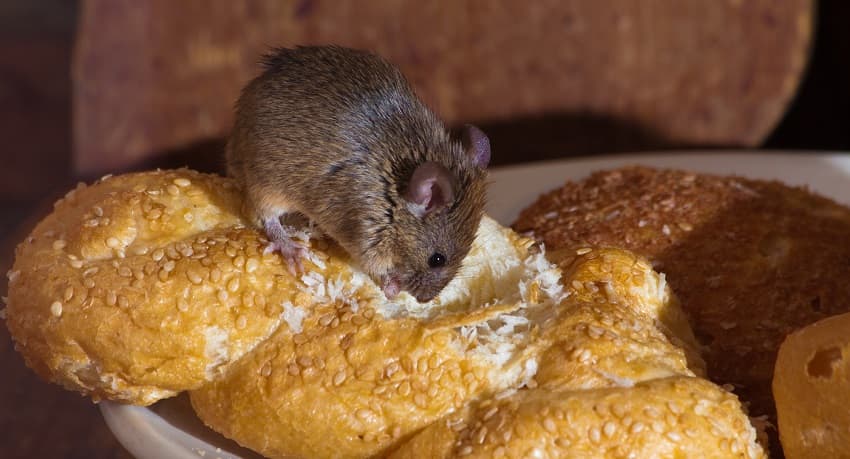Are you hungry for mice? Probably not.
But that doesn’t mean you can’t eat them in an emergency. Not only are mice edible, but they’re also packed with protein and micronutrients.
Munching on mice might freak you out, but there’s no need to panic. If you’re willing to open your mind and whip out your chef skills, these little rodents can be downright delicious.
Is Mouse Meat Safe to Eat?
Many people are prejudiced when it comes to eating rodents. It’s true that mice can carry dangerous illnesses like hantavirus and toxoplasmosis. However, this doesn’t automatically rule them out as a food source. As long as you’re careful, you should be able to eat mice without issue.
Check out Michelin-star Chef Heston Blumenthal’s thoughts on mice as culturally taboo and learn what happens when people overcome their fear of trying new things.
Of course, you don’t have to take my word for it. People around the globe regularly eat mice, and many experts agree that rodent farming could be a sustainable solution to world hunger issues.
Eating mice that are raiding your garden can eliminate the pest problem and save your crops. And since mice populate so quickly, it isn’t really that far-fetched to consider raising them for food.
However, you probably don’t want to dive into a full-scale mouse farm yet. If you’re simply seeking some emergency sustenance on the fly, the first step is choosing edible mice from the local populace.
Choosing Edible Mice

The concept of eating mice is foreign to us, so it’s scary. But just because your local grocery store doesn’t sell them doesn’t mean you can’t eat them. In many regions, mice are sold in the supermarket. However, these aren’t the same mice you’d find festering in a New York City dumpster.
So, what’s the difference? The rodents’ diet.
You are what you eat. Mice that live in cities hang around trash cans for free food. They may nest in sewers to stay warm and protected. As they live in filth and eat garbage, they pick up diseases. Essentially, they become garbage themselves—you don’t want to eat that.
Furthermore, city mice live in large colonies. If their population gets too large or they experience a food shortage, mice will resort to cannibalism and eat each other’s corpses. Cannibalism-related illnesses are known as prion diseases and can be spread from animals to humans, so eating city mice is a big no-no.
Field and farm mice are a much safer bet. They usually eat a healthy diet of grain, seeds, fruit, and berries. They don’t nest in sewers, so there’s less risk of waste-borne pathogens.
Country mice also have more space and safety to grow their colonies. Predators cull their population naturally, keeping the colony small and sustainable. Because of this, they are less likely to engage in cannibalism or carry prion diseases.
The bottom line?
Choose mice from wild populations living in forests, fields, and farms.
Preparing Mice Safely
So, you’ve caught a bushel of field mice. You’ll need to prepare and cook the mice properly to have a safe dinner. As long as you follow the proper technique for dressing and cooking wild game, you’ll be fine.
Top tips on preparing mice safely:
- Wear gloves during every step of the process. Like all wild game, mice can have bacteria in their skin and organs. Wearing gloves prevents the bacteria from migrating to your skin and organs.
- Wash your hands thoroughly, even though you wore gloves. Wash all your dressing equipment as well. This will help prevent contamination at every level.
- Remove the mouse’s head and intestines. The head is where prion diseases live, and the intestines can have toxoplasma bacteria and salmonella.
- Before you cook it, rinse the mouse carcass thoroughly with water. Some people remove the skin before cooking, but others char the skin and then remove it. Either one is fine, but don’t eat the skin or fur.
- Cook the mouse to a temperature of 165°F. Cooking mice thoroughly will kill any parasites in the meat and wipe out leftover bacteria.
- Many people catch mice and store them alive to eat later. If you do this, treat them with dignity by keeping their cage clean and providing them with food and water. This will prevent waste-borne bacteria from running rampant and minimize the likelihood of cannibalistic tendencies popping up.
Is Mouse Meat Good for You?
Mouse meat is excellent for you! The raw nutritional breakdown varies widely across different species, but all mice are a great source of protein. Some come packed with healthy fats, too. Domestic mice and white-footed mice have more significant fat percentages, while field mice and jumping mice are mostly lean.
Unfortunately, all mice are pretty small. Adults can weigh anywhere from 15 to 50 grams depending on the species. You’d need to catch anywhere from three to seven mice to make a four-ounce portion of mouse meat. Such a portion would have roughly 200 calories for a leaner species and 250–300 for a fattier species.
Mice are also rich in vitamins A, K, and E. They’re a great source of iron, magnesium, manganese, and zinc. Cooking the bones and cartilage down into a bone broth will yield calcium and additional protein.
Bone broth is incredibly helpful in a survival scenario because it staves off vitamin deficiencies and contains essential amino acids that help fight inflammation. Interestingly enough, we discovered the benefits of drinking bone broth by studying mice themselves.
What Does Mouse Meat Taste Like?
Mice taste vaguely similar to other rodents, such as beavers, squirrels, and rats. They may have a gamey and pungent undercurrent because they secrete scent markers to communicate socially with other mice. These scent markers tend to add an unpleasant odor to the meat.
If you wash them and remove the skin, you can eliminate much of the pungency. This will leave you with a sweeter, milder meat that many people believe tastes more like pork or chicken. Mice prepared with a bit of panache can be tender, juicy, and flavorful.
Some types of mice are rich, and others are leaner. Many contain more fat than rats and rabbits. The high fat content contributes a mountain of flavor, so they tend to be less stringy with a more well-rounded flavor profile.
Is It Legal to Hunt and Kill Mice?
Unfortunately for mice, people hate them. These little critters can be a big problem in country homes and especially on farms, where they nest in grain and eat their fill of crops.
Because they can’t seem to stop scavenging our food and eating through our electrical wiring, mice are classified as nuisance animals in most states.
Why is this important? It means you can legally kill them at will. They’re largely unprotected under wildlife management laws, so there’s no chance of the game warden coming around to arrest you for illegal mouse-hunting. Of course, rules can vary by city and county. It’s important to ensure that your method to hunt and kill mice is legal in your region, especially if you live within city limits.
How to Catch Mice
Go ahead and put away the shotgun. No matter how hungry you are, you can’t shoot a mouse. Especially not one you intend to eat.
Hunting mice the traditional way won’t do you very much good in a survival scenario. Hunting and stalking take valuable time and energy, which you need to conserve. Mice are also nocturnal creatures, and you don’t want to stay awake all night waiting for them.
The easier and smarter option is to set traps. Mice are tiny and don’t provide much meat, so you’ll need several animals to make a decent meal. In light of this, setting multiple traps is a good idea.
At first, you can put them in different areas. As you get an idea of where the mice prefer to hang around, you can concentrate your efforts on those parts of the property.
Using a live trap is better than using one that kills the mice. They will begin to rot immediately after death, and you don’t want to eat spoiled meat. You can make a bucket mousetrap or buy one online, but it’s wise to be prepared with a trap if an emergency strikes.
Primitive Mouse trap
Traps to Consider
A cage trap like the Kensizer Mouse Trap will work well in an outdoor survival scenario. It’s metal and sturdy enough to hold mice or rats while staving off predators like birds. People have reported catching multiple mice inside simultaneously, which will cut down on the amount of work you need to do.
If you want a dedicated system for catching multiple mice, a bucket trap like the BOTARO Bucket Trap will do the trick. It baits the mice out on a platform, where gravity then causes them to fall into a bucket.
Depending on where you live, a bucket trap might be better indoors. Bucket traps can attract predators that might knock it over or destroy it, eating all your mice and ruining your culinary progress.
Dispatching Mice
Once you catch mice, you need to kill them. A quick and painless dispatch is the best way to go, as it ensures your mice live out their final moments in relative peace. It’s also better for you because animals secrete adrenaline during stress. If your mice are scared, the adrenaline makes them taste bad and can even cause the meat to spoil faster.
So, how to kill them kindly? Kill them quickly. Employ cervical dislocation to sever the spine-brain connection and cause instant death. Put on gloves and pick the mouse up carefully, so you don’t get bit.
Grip its neck and head firmly in one hand and hold the base of the tail in the other. With one quick twisting motion, pull back the tail and hind legs while pulling the head in the opposite direction. The mouse should die instantly.
How to Prepare Mouse Meat
A mouse might be a tiny creature, but you should field dress it like any other wild game. Field dressing helps lower the meat’s temperature and kick-starts the preservation process immediately. Once you catch a mouse, eviscerate it and remove the organs.
Some people leave the head on, but removing it will further aid in temperature control. The choice is yours. Either way, you should rinse the carcass thoroughly in cold water to wash away any remaining blood and viscera from the body cavity.
Ready to get your chef on? You can cook mouse meat in various ways, from charring it over the fire to deep-frying it in oil. If you plan to make mice a regular part of your dinner table, consider incorporating some classic mouse recipes into the mix.
Check out this delicious Vietnamese recipe for marinated field mice to get some culinary ideas.
Creamed mice, stuffed mice, and marinated mice on the grill are all popular options among people who eat lots of mice. The Entrecote à la bordelaise is an exquisite-sounding French dish calling for mice that drink wine. The mice are glazed and then roasted over a fire of old wine barrels. Yum!
Of course, you might not want to let the mice get at your wine supply. It’s much more likely you’ll be grilling them over a fire in a survival scenario, but anything can happen.




Protein is protein in a survival situation.